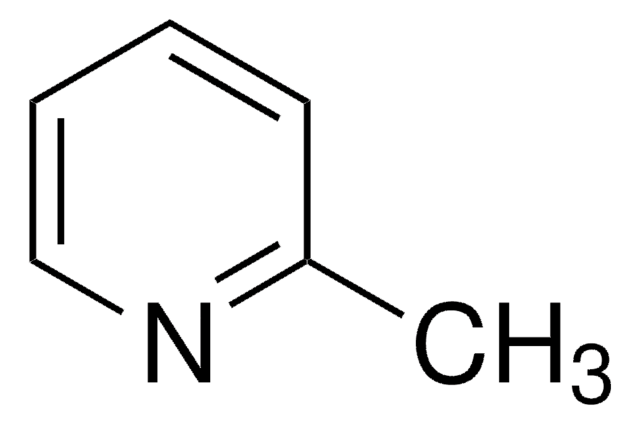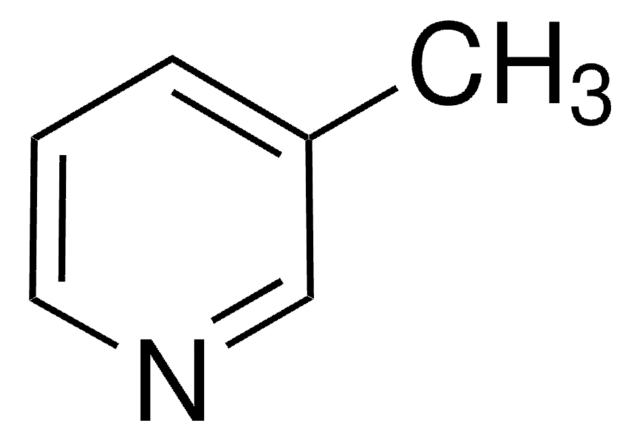Kluczowe dokumenty
74350
2-Picoline
analytical standard
Synonim(y):
α-Picoline, 2-Methylpyridine, NSC 3409
About This Item
Polecane produkty
klasa czystości
analytical standard
Poziom jakości
gęstość pary
3.2 (vs air)
ciśnienie pary
10 mmHg ( 24.4 °C)
Próba
≥98.5% (GC)
temp. samozapłonu
995 °F
okres trwałości
limited shelf life, expiry date on the label
granice wybuchowości
8.6 %
metody
HPLC: suitable
gas chromatography (GC): suitable
zanieczyszczenia
≤0.5% water
współczynnik refrakcji
n20/D 1.499-1.502
n20/D 1.500 (lit.)
bp
128-129 °C (lit.)
mp
−70 °C (lit.)
gęstość
0.943 g/mL at 25 °C (lit.)
Zastosowanie
cleaning products
cosmetics
flavors and fragrances
food and beverages
personal care
Format
neat
ciąg SMILES
Cc1ccccn1
InChI
1S/C6H7N/c1-6-4-2-3-5-7-6/h2-5H,1H3
Klucz InChI
BSKHPKMHTQYZBB-UHFFFAOYSA-N
Szukasz podobnych produktów? Odwiedź Przewodnik dotyczący porównywania produktów
Opis ogólny
Zastosowanie
- Cigarette smoke using reversed-phase high-performance liquid chromatography–electrospray ionization tandem mass spectrometric method (RP-HPLC–ESI-MS/MS).
- Chinese faint-scent cigarettes using gas chromatography–mass spectrometry (GC–MS) technique.
Hasło ostrzegawcze
Danger
Zwroty wskazujące rodzaj zagrożenia
Zwroty wskazujące środki ostrożności
Klasyfikacja zagrożeń
Acute Tox. 3 Dermal - Acute Tox. 4 Inhalation - Acute Tox. 4 Oral - Eye Dam. 1 - Flam. Liq. 3 - Skin Corr. 1C - STOT SE 3
Organy docelowe
Respiratory system
Kod klasy składowania
3 - Flammable liquids
Klasa zagrożenia wodnego (WGK)
WGK 1
Temperatura zapłonu (°F)
84.2 °F - closed cup
Temperatura zapłonu (°C)
29 °C - closed cup
Wybierz jedną z najnowszych wersji:
Certyfikaty analizy (CoA)
Nie widzisz odpowiedniej wersji?
Jeśli potrzebujesz konkretnej wersji, możesz wyszukać konkretny certyfikat według numeru partii lub serii.
Masz już ten produkt?
Dokumenty związane z niedawno zakupionymi produktami zostały zamieszczone w Bibliotece dokumentów.
Protokoły
US EPA Method 8270 (Appendix IX): GC Analysis of Semivolatiles on Equity®-5 (30 m x 0.25 mm I.D., 0.50 μm)
Nasz zespół naukowców ma doświadczenie we wszystkich obszarach badań, w tym w naukach przyrodniczych, materiałoznawstwie, syntezie chemicznej, chromatografii, analityce i wielu innych dziedzinach.
Skontaktuj się z zespołem ds. pomocy technicznej








